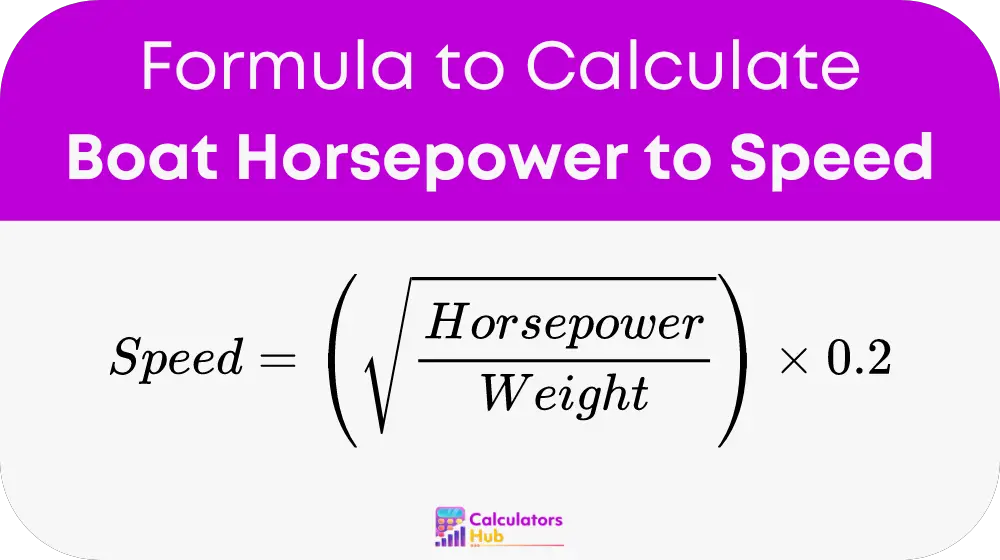The Boat Horsepower to Speed Calculator estimates the top speed of a boat using the engine's horsepower and the boat's weight. This tool can help in various scenarios, such as selecting the right engine for your boat, predicting travel times, and improving fuel efficiency. By inputting the horsepower and weight, users can quickly see how these factors influence their boat's speed.
Formula of Boat Horsepower to Speed Calculator
The formula used by the Boat Horsepower to Speed Calculator is:

Here's what each variable represents:
- Speed: The estimated top speed of the boat in knots or miles per hour (depending on the constant used).
- Horsepower: The shaft horsepower, which is the actual engine horsepower minus drivetrain losses.
- Weight: The total weight of the boat, including passengers, cargo, fuel, and anything else onboard. Ideally, use the boat's actual running weight, not the dry weight.
- Constant (0.2): This value depends on the hull design of the boat. Different hull types (e.g., deep V hull, pontoon) will have different constants. Finding an accurate constant can be challenging as it varies based on factors like prop pitch and water conditions.
This formula assumes certain factors such as the boat's hull design, water conditions, and other variables remain constant.
Practical Table for Common Terms
To make it easier for users, here's a table with pre-calculated speeds for common horsepower and weight combinations:
| Horsepower | Weight (lbs) | Speed (knots) |
|---|---|---|
| 100 | 2000 | 2.83 |
| 150 | 3000 | 2.58 |
| 200 | 4000 | 2.45 |
| 250 | 5000 | 2.35 |
| 300 | 6000 | 2.30 |
This table provides quick reference speeds without needing to perform the calculation each time.
Example of Boat Horsepower to Speed Calculator
Let's go through an example to see how the formula works in practice.
Example Calculation:
- Horsepower: 200
- Weight: 4000 lbs
Using the formula: Speed = √(200 / 4000) * 0.2
- Divide the horsepower by the weight: 200 / 4000 = 0.05
- Take the square root of the result: √0.05 ≈ 0.224
- Multiply by the constant: 0.224 * 0.2 ≈ 0.045
So, the estimated top speed of the boat is approximately 0.045 knots.
Most Common FAQs
A1: The calculator provides an estimate based on the input values and assumes constant conditions. Actual speed can vary due to factors like water conditions, hull design, and propeller efficiency.
A2: Yes, but keep in mind that the constant (0.2) may need adjustment for different hull designs. This value is a general approximation and might not be accurate for all boat types.
A3: If there's a large discrepancy, consider factors like hull fouling, propeller condition, and weight distribution. These can all impact the boat's performance and may need to be checked.
Wrong.
CS27 sailboat weighs 6500lbs and comes with a 7.5hp diesel engine which pushes it to a measured 5.5mph. I’ve done that many times over 12 years.
Don’t know where you got the formula for this calculator, but it is worse than useless.
Thank you for your comment regarding the accuracy of the calculator. It’s clear that your experience with the CS27 sailboat provides valuable real-world insight.
The calculator is designed to estimate speeds based on generalized formulas that consider horsepower and weight. It assumes standard conditions and an average hull design, often simplifying the wide variability in real-world factors like hull efficiency, propeller slip, and water conditions. Specifically, the formula used on the site simplifies these dynamics and applies a fixed coefficient that might not match specialized designs like the CS27 sailboat.
Your example highlights how these estimations may not align with actual measurements for specific boats. A diesel engine’s efficiency, the boat’s displacement, and its design (e.g., whether it operates near its hull speed) significantly affect real-world performance. For displacement hulls like the CS27, speed is often constrained by the hull speed formula rather than engine horsepower alone.
We’ll consider updating the calculator to reflect a broader range of boat designs or provide a disclaimer emphasizing its limitations for specialized cases. If you have additional insights or examples, we’d love to incorporate them to improve accuracy.